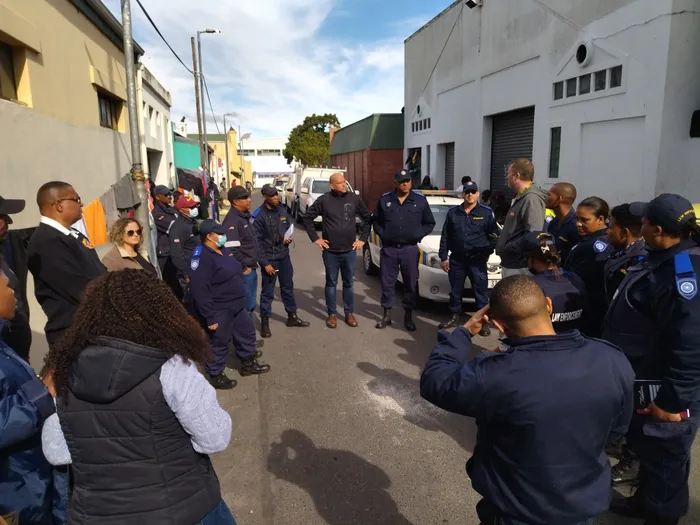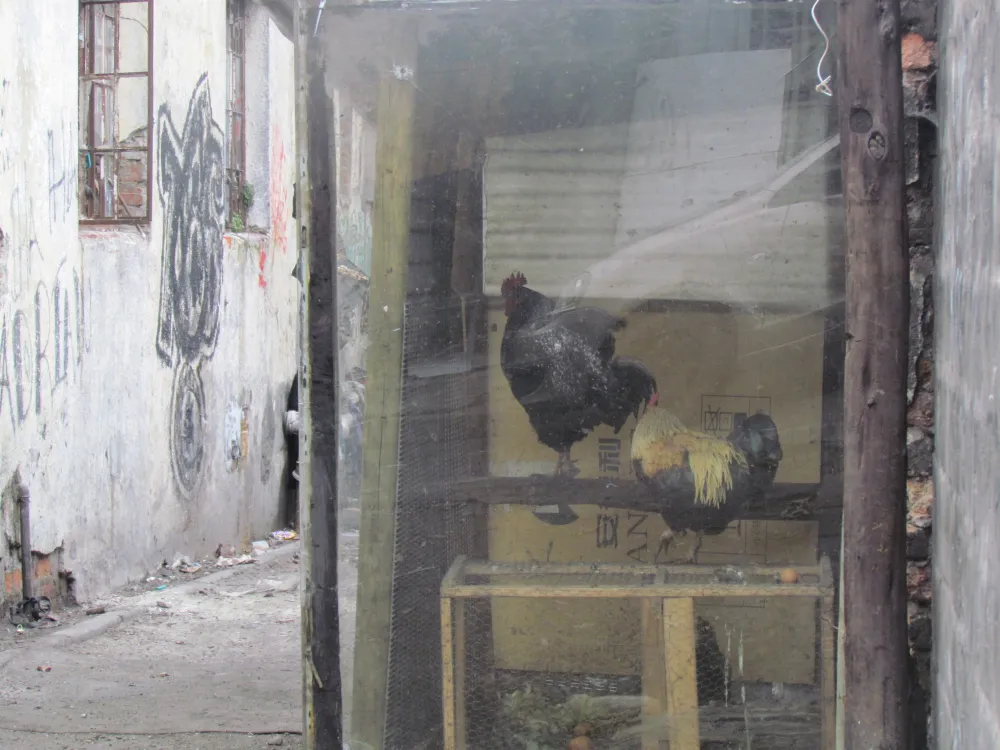Pushback against slum creep continues

City officials gather during an inspection of buildings in Ebor and Wynberg Main roads.
The drive to rid the heart of Wynberg of slums continued last Friday as City law enforcement officers escorted health-and-safety inspectors on a tour of properties between Wynberg Main Road and the railway line to write up by-law infringements.
The story goes back to 2013 when the old Uli Heydt Butchery was declared a problem building. Mr Heydt went into voluntary business rescue after the City’s corporate finance department took him to court over a R5 million debt. A deal was made that saw the debt reduced to R1.3 million and the properties removed from the City’s top-10 problem-buildings list. However, the City says Mr Heydt reneged on the deal by not paying up.
Since then, former ward councillor Liz Brunette and the current one, Emile Langenhoven, have tried to have the properties declared problem buildings again.
Mr Heydt owns 8 and 10 Ebor Road and 263 Main Road, which is divided by Ebor Lane. All three properties span the block and were once part of a thriving butchery business in its day.
Sub-council chairperson Xanthea Limberg made a site visit on Monday June 13. She was joined by mayoral committee member for safety and security JP Smith who told Mr Heydt that unless he found a way to fix his properties, the City would take him to court for debt collection and problem-building infringements (“City vows to act against owner of slum buildings”, Bulletin, June 16).
During that site visit, officials found people living in makeshift dwellings behind security gates at 8 and 10 Ebor Road.
In Wynberg Main Road, people live in dark, windowless rooms with dodgy electrical wiring and a lack of running water.
Dividing the block is Ebor Lane, where a wall has been built illegally.
On Tuesday June 28, a gate blocking access to Ebor Lane was removed by the City’s roads and stormwater department.
Last Friday, when City officials tried to get into 10 Ebor Road, they found their way blocked by a locked security gate.
Senior law enforcement manager Clinton Overmeyer said Mr Heydt had been given a week’s notice about the inspection and could have attended, but he had instead sent a representative from a legal firm.
After unsuccessfully requesting access from bystanders and Mr Heydt’s representative, law enforcement officers began removing the lock on the gate. It was then that a woman suddenly appeared with the key.
Inside number 10, it was dark with water and broken tiles underfoot, and the sound of water dripping could be heard above.
A tiled corridor led to Ebor Lane where people sat on crates and old couches. An officer shone a torch into a white, plastic bin filled with faeces. Another couch at the illegal wall was surrounded by broken clothing and litter. A red teddy bear lay among the detritus.
A woman in the lane said she had been living there for a decade and made a living from “hustling”. She asked whether the building could be turned into a rehab centre.
Near the entrance to the lane, officials found that a chicken coop had been built since the gate had been removed.
Inside number 10, there were signs of what must have once been a thriving butchery: cold-storage rooms and high ceilings from where carcasses once hung but from where live electricity wires now dangled.
Sub-council manager Richard White said it resembled a set for a dystopian movie.
In what was once a kitchen, health officials tried to identify a black goo on the floor. One of them shone a torch into a cupboard and screamed as two pairs of rats’ eyes glared back. The humid air was a mixture of human waste, food cooking, burning candles and decay.
In another section of the building, law enforcement officers forced open a door to a dark cubicle occupied by about five people including some children wearing school uniforms. A smartly dressed man outside offered his business card for the company he works for laying artificial grass. He said he paid rent to someone whose name he did not know.
Mr Overmeyer said the various departments would have a follow-up meeting. All departments present for the on-site inspection would compile their own assessment of the buildings and, if necessary, serve a notice of compliance on the owner of the properties who would then be given an opportunity to remedy any problems.
During the June site visit, Mr Heydt left before the inspection due to poor health. However, before he left, he told the Bulletin that he had owned the properties for over 30 years before going into liquidation. He said he now owed the City R2.2m, but it could be more, and his approximately 80 tenants, who were mainly foreigners, had not been paying rent during Covid. He said he wanted to sell the properties.
We tried to get comment from Mr Heydt about the recent inspections, but he did not respond.









